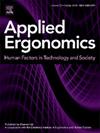Wearable weight distribution devices for reducing injury risk: How varying amounts of body armor offloading affect biomechanics and comfort
IF 3.4
2区 工程技术
Q2 ENGINEERING, INDUSTRIAL
引用次数: 0
Abstract
Soldiers experience high rates of back injuries from wearing heavy body armor. Wearable weight distribution devices that offload body armor weight to the hips might help mitigate injury risk. However, it is unclear how much offloading is practical without negatively impacting comfort or biomechanics. We explored this knowledge gap by testing 13 veterans while wearing a 15.6 kg body armor vest and a novel weight distribution device. For each trial, the device was adjusted to offload a percentage of the body armor weight. We tested four conditions: ZERO (0%), LOW (∼30%), MED (∼60%), and HIGH (∼90%). We found that LOW, MED, and HIGH offloading of the shoulders and back did not negatively affect trunk muscle activity or posture. Overall user comfort also improved. All participants preferred a portion of the body armor weight distributed to their hip belt, highlighting the potential for these devices to relieve people in occupations that wear body armor.
减少受伤风险的可穿戴重量分配装置:不同数量的防弹衣卸载如何影响生物力学和舒适度
士兵们穿着厚重的防弹衣背部受伤的几率很高。可穿戴的重量分配设备可以将防弹衣的重量转移到臀部,这可能有助于降低受伤的风险。然而,目前尚不清楚在不影响舒适性或生物力学的情况下,实际卸载多少载荷。我们通过测试13名退伍军人,让他们穿着15.6公斤的防弹衣背心和一种新型的体重分配装置,来探索这种知识差距。对于每次试验,该装置被调整为卸载一定百分比的防弹衣重量。我们测试了四种条件:ZERO(0%)、LOW(~ 30%)、MED(~ 60%)和HIGH(~ 90%)。我们发现肩部和背部的低、中、高负荷负荷对躯干肌肉活动或姿势没有负面影响。整体用户舒适度也有所提高。所有的参与者都喜欢将一部分防弹衣的重量分配到他们的臀带上,这突出了这些装置在减轻穿着防弹衣的职业人员的压力方面的潜力。
本文章由计算机程序翻译,如有差异,请以英文原文为准。
求助全文
约1分钟内获得全文
求助全文
来源期刊

Applied Ergonomics
工程技术-工程:工业
CiteScore
7.50
自引率
9.40%
发文量
248
审稿时长
53 days
期刊介绍:
Applied Ergonomics is aimed at ergonomists and all those interested in applying ergonomics/human factors in the design, planning and management of technical and social systems at work or leisure. Readership is truly international with subscribers in over 50 countries. Professionals for whom Applied Ergonomics is of interest include: ergonomists, designers, industrial engineers, health and safety specialists, systems engineers, design engineers, organizational psychologists, occupational health specialists and human-computer interaction specialists.
 求助内容:
求助内容: 应助结果提醒方式:
应助结果提醒方式:


